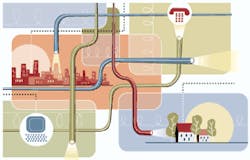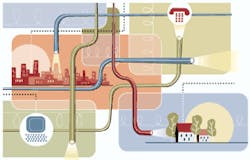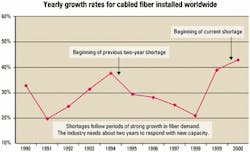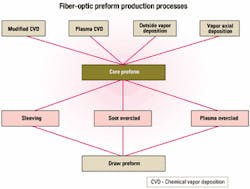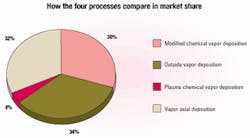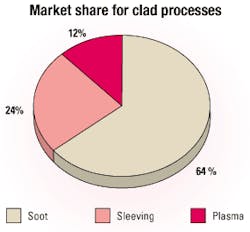Impact of the ongoing fiber shortage
Recent developments in the fiber industry highlight the cyclical nature of fiber manufacturers' ability to meet demand.
RICHARD MACK, KMI Corp., and ARNAB SARKAR, Bular LLCThe optical-fiber shortage that started in 1999 has continued for more than 24 months and as of midyear 2001 was still affecting many fiber and cable manufacturers. It therefore has been one of the most acute and extended shortages in the 20-plus years of the fiber industry.
This shortage caught the industry off-guard, as a combination of events triggered a jump in the annual growth rate of fiber production from its historic average of 20% to 30% to rates of 40% in 1999 and even higher in 2000. The industry responded with unprecedented expansion plans, both by the major fiber-producing groups and by the independent fiber companies. In addition, there have been announcements for new factory startups in China, Russia, India, and other emerging markets.
Now, the U.S. economy is in a downturn. Major communications markets around the world are experiencing a slowdown in the flow of capital. Stock prices in the telecommunications industry have dropped sharply, reducing availability of funds for the kind of growth that was seen in year 2000. The questions on everyone's mind are how long before the fiber market will shift to a glut of fiber-making capacity and how bad will it get before it gets better?
The optical-fiber industry, not unlike the semiconductor industry, has been cyclical in nature, with periods of excess capacity followed by a period of excess demand. That's not surprising, because the industry is equally capital-intensive, producing annual revenue comparable to the amount invested in production facilities. In other words, producers have a difficult time justifying investments at periods of excess capacity and falling prices, leading to a shortage as growth in demand catches up with installed capacity. Then prices stabilize or grow, which incites a spurt of investment to meet the demand.
Traditionally, three main factors have driven market growth: new technologies; penetration of optical communications system into a new segment of the communication infrastructure (or new applications); and deregulation of the telecom industry. The first shortage of significance was in 1983-84 after the introduction of singlemode-fiber systems in the U.S. long-distance networks. The second shortage in 1986 was driven by installation activities by the local Bell operating companies formed by the breakup of AT&T Jan. 1, 1984.
After this shortage, there was a period of relative predictability through the early 1990s, continuing into 1994, when a series of events took place. Global deregulation opened up more international markets. Competition ramped up in U.S. access networks with installations by competitive access providers (CAPs), later known as competitive local-exchange carriers (CLECs). Also, in the early 1990s, advances in laser technology resulted in practical and cost-effective architectures for cable TV operators, which were installing optical headend and distribution backbone networks. In 1994, fiber demand in the cable TV segment more than doubled and by 1995 the cable TV segment consumed more fiber than the Bell companies. Other segments, including submarine, also experienced rapid growth, driven by growing data traffic.The upshot was a shortage that began in the third quarter of 1994 and by year-end was affecting every fiber and cable company around the world. The shortage eased in late 1996 or early '97 due to global expansion of capacity. Shortly thereafter, the world's fiber-making capacity exceeded demand by as much as 30%. In 1997 and '98, prices fell around the world. Several major fiber manufacturers became more cautious with expansion plans-and the spending on some new facilities was scaled back to better match current market conditions.
This situation, however, was short-lived. The explosion of network construction worldwide, including demand for nonzero dispersion-shifted fiber (NZDSF), increased total fiber demand beyond capacity for some manufacturers in late 1998 or early '99, and this shortage has continued into 2001.
Most fiber manufacturers do not disclose detailed information concerning their capacity. However, some manufacturers issue press releases and other statements about expansion plans, new factories, acquisitions, etc. This information, along with other input from industry sources, can provide the basis for reasonable capacity estimates.
Table 1 summarizes input from press releases and other sources concerning investments in fiber-making capacity. In some cases, the corporate announcements refer to investments (in dollars) for multiyear programs, and KMI has tallied these figures based on the year announced. In other cases, the announcements refer to a percentage increase in capacity, and KMI has estimated the investment levels.
Therefore the figures for each year in the Table were not announced by the companies but are KMI's estimates and should be used as a guideline for the approximate level of investment in new fiber-making capacity. The main point is that the Table shows a considerable increase in investment in response to the shortage that began in 1999.Bular LLC has developed cost models that compute investment intensity for the different fiber-making processes. By using these cost models and the avail able information on capacity expansion, we estimate that the total of $2.6 billion estimated for 2000 could bring the world's aggregate fiber-making capacity to a level of 165-175 million fiber-km per year by the end of 2002.
Again, these announcements are for multiyear expansion plans, and past experience shows that it can take years for a company to bring new capacity up to full production. Depending on how rapidly this new capacity is brought online and the duration of the present downturn in capital expenditure, the current fiber shortage is ending in 2001, and excess capacity will extend into 2002 (see Figure 1).
Two new families of fiber products were introduced in the second half of the 1990s. The first is NZDSF for high-bit-rate DWDM systems. These fibers have been used primarily in long-distance and submarine networks. There are a multitude of fiber designs; a reduced-slope NZDSF like Truewave-RS introduced by Lucent Technologies and a large effective-area fiber (LEAF) introduced by Corning dominate the market primarily because of the patent position of the companies in these new products. Alcatel's TeraLight fiber is a compromise design with a larger area than Lucent's Truewave-RS and a lower slope than Corning's LEAF.All the major fiber-producing groups can produce NZDSF, but their market share is limited by their ability to sell without infringing on Corning and Lucent's patents. In 2000, NZDSF was 20% of the worldwide fiber market in terms of fiber-kilometers. This market share is expected to peak at no more than 30% in the near future (less than two years) due to a saturation of fiber in long-distance network installations.
The second fiber type is a low-water, hydrogen-resistant singlemode fiber that was introduced first by Lucent in 1998 as Allwave fiber. Earlier this year, Corning introduced a low-water fiber called SMF-28E. Both fibers target metropolitan-area and access networks that use coarse WDM (CWDM) systems.
Low-water fiber allows use of the entire wavelength range from 1,270 to 1,650 nm. This range cannot be used with conventional singlemode fibers (CSMF), which have an absorption peak at 1,385 nm due to hydroxyl ion content. The low-water fiber is covered by ITU proposal PN-4590, to be published as TIA/EIA-492CAAB. As of midyear 2001, low-water fiber had a very small market share. But if this product replaces CSMF in the metro and access networks, companies that cannot produce such fiber will face a severe problem.
There are four preform-producing pro cesses: modified chemical vapor deposition (MCVD), plasma chemical vapor deposition (PCVD), outside vapor deposition (OVD), and vapor axial deposition (VAD). MCVD and PCVD require a deposition tube, inside of which additional glass is deposited. OVD and VAD do not use a purchased tube, and 100% of the glass of the preform is produced by the preform-producing company.
In a second step with all of these processes, additional clad glass is added to complete the preform so that it is ready to be drawn into a fiber. There are three commercial processes of adding clad glass. The simplest clad process, sleeving, simply requires collapsing a silica tube on the core preform. Sleeving is the most commonly used clad process for MCVD and PCVD core preforms. It requires a second tube, which can be made by chemical vapor deposition (CVD tube) in a process very similar to OVD or a liquid-state process called sol-gel. The other two processes of adding clad glass on a core preform or an elongated rod of the core preform is called soot overcladding and plasma overcladding. The different process options are schematically shown in Figure 2.
Since MCVD was the first process to mature (in the 1970s), the initial multimode fibers were mostly MCVD fibers, with VAD and OVD processes producing smaller quantities. The switch to singlemode fibers in the early 1980s coincided with the maturing of the OVD and VAD processes. In the '80s, Corning and Furukawa stopped using the MCVD process.
In the 1990s, the number of VAD fiber producers increased dramatically with Shin-Etsu, Hitachi, Mitsubishi, and Showa in Japan obtaining licenses from NTT. Pirelli developed and commercialized the VAD process in Europe with a license from Sumitomo. Also in the 1990s, Lucent acquired a license from Sumitomo and introduced VAD in its Atlanta factory. That was done after Lucent had an opportunity to observe VAD in production for several years at its Litespec joint venture with Sumitomo in the United States.One result of these developments is that the share of the MCVD process decreased throughout the '90s. In CSMF production, the ability to produce larger preforms made OVD and VAD more attractive, and that contributed to the decreasing share of MCVD through the early 1990s.
Introduction of synthetic fused silica deposition tubes by Heraeus and Shin-Etsu Quartz allowed MCVD and PCVD preform producers to use smaller thicknesses of deposited clad ding, and that allowed a rapid increase in MCVD and PCVD perform size, breathing new life into these processes. Current market share of core processes is shown in Figure 3.
MCVD remains strong at several manu facturers in conjunction with the use of sleeving tubes. Further, the ability to tailor a fiber's refractive-index pro file more accurately with the MCVD or PCVD process makes these processes dominant in the multimode segment. On the other hand, low-water-type fi bers are easiest to produce by VAD and OVD methods, so that market share can tilt one more time toward VAD and OVD if these products gain market share.
A gain in the market share of re duced-slope NZDSF could reverse the continuously eroding trend of the market share of MCVD and PCVD processes. All the core processes can produce the large-effective-area NZDSFs. But the reduced-slope NZDSFs, which require alternating layers of raised index layers having germania doping and lowered index layers having fluorine doping, are more easily produced with the MCVD and PCVD processes. Therefore, an increase in production volume of reduced-slope NZDSF could increase the use of MCVD and PCVD processes. Efforts to offer a wide range of products for dispersion management also could rekindle interest in the MCVD or PCVD processes at Corning or at the large VAD manufacturers like Sumitomo, Fujikura, Furukawa, and Shin-Etsu.
Conversion of preform fabrication to a two-step process by combining sleeving with a core preform started with the early commercialization of the VAD process. In the early '80s, Corning first commercialized soot overcladding. Decline in market share of sleeving continued through the '80s as all the VAD fiber producers switched to soot overcladding. In the late '90s, the switch from sleeving to soot overcladding has accelerated with commercial availability of equipment and technology from multiple equipment vendors.Also in the '90s, Alcatel switched its clad process from sleeving to plasma overcladding. Through the mid-'90s, all of the sleeving tubes were produced by the CVD process, but now a small but significant volume of sleeving tubes are produced by Lucent using the sol-gel process. However, it is interesting to note that even though the market share of sleeving has been dropping, growth in fiber production has continued to increase the demand for both deposition and sleeving tubes; that trend is expected to continue in the near future. The growth of the sleeving-tube market has actually been so rapid that Heraeus and Shin-Etsu Quartz have not been able to keep up with demand, and there is a shortage of tubes on the market. Figure 4 shows comparative market share among the clad processes.
It appears that, like the semiconductor industry, the optical-fiber industry will remain cyclical in nature. That's because manufacturers cannot maintain excess capacity and be price-competitive, and market growth will continue to be in spurts, affected by the periodicity of the global economy and other factors in the telecom market.
The current shortage of fiber is expected to ease by the end of this year, with a short period of excess capacity before demand once again catches up with capacity. The length of this period of excess capacity will depend on the global economy as well as the industry's capital investment in fiber-making capacity, but the last such period of excess capacity lasted about two years.
The average growth of the industry may drop significantly from the heady years of 1999 and 2000. One forecast scenario analyzed by KMI showed a near-term year-on-year growth rate of about 19%, and that could extend into 2002. But past experience shows that the year-on-year growth rates have not stayed at the same level for more than two years and that they generally fall between 20% and 30%.
It is likely that the market for NZDSF will saturate at a level below 30%, then gradually decrease to a lower but stable market share as long-distance network installations reach equilibrium with traffic requirements. The low-water singlemode fiber will further erode market share of standard singlemode fibers, and it would not be surprising to see its share grow to a level of 10% or more by 2005.
The major integrated fiber producers will continue to dominate the industry. But fiber drawn from purchased preforms will continue to increase. In 2000, Shin-Etsu, the dominant preform supplier, announced a new production facility to double its capacity to 24 million fiber-km per year, then later revised its announcements to say that the company will increase its capacity to 36 million fiber-km per year. This expansion could affect the market share of the VAD process, the process Shin-Etsu uses to produce preforms.
Another development in the next few years will be the advent of new fiber producers having annual capacity of 1-5 million fiber-km. Several such startups are expected to begin producing fibers in countries like China. Continued growth of Shin-Etsu's preform business will continue to increase the domestic capabilities in Russia, India, Brazil, Malaysia, and South Africa, and the combined share of the independent producers may hold its own or grow slightly through the first half of the next decade.
Richard Mack is vice president and general manager of KMI Corp. (Providence, RI), a market-research and consulting firm specializing in fiber optics and telecommunications. KMI is a subsidiary of PennWell Corp., which also owns Lightwave magazine. Dr. Arnab Sarkar is president of Bular, a consulting company in optical fibers, and is chairman and chief technical officer of Optical Fiber Engineering. He can be reached at [email protected].
How will the fiber and cable industry withstand these new changes in the demand trend? That depends on the industry's structure, which has evolved considerably since the mid-1990s. After recent acquisitions and mergers, the industry seems to have settled into a situation in which integrated producers-companies that manufacture performs, fiber, and cable-represent more than 90% of the current fiber market.
Corning, which has been the world's largest manufacturer of fiber, was also the largest independent supplier of fiber, selling to many cable companies around the world. But in recent years, Corning pursued a strategy of investing in or acquiring cable manufacturers, including the major shift completed last year when it finalized its acquisition of Siemens's share of Siecor plus other Siemens cable-manufacturing facilities.
Eight integrated multinational fiber and cable manufacturers represent the top of the worldwide market. For these companies, it appears that being an integrated perform, fiber, and cable producer is the best way to ensure market access and profitability in the major telecommunications markets. Other smaller companies tend to focus on domestic or regional markets and product niches.
For example, Shin-Etsu, a Japanese preform producer, has been struggling against this tide from the early '90s, and to the surprise of some industry participants, by 2000 had gained as much as 10% of the preform market. Shin-Etsu's strategy is twofold: One part is to produce and sell performs to the integrated fiber and cable companies to supplement their in-house perform production, and the second part is to supply to "draw-only" independent companies around the world.
If Shin-Etsu stays on target with its expansion plan, which will raise preform production capacity to a level representing 36 million fiber-km per year, the company could have the potential to increase its share to somewhere between 20% and 25% of the fiber market. Such a scenario would make Shin-Etsu the world's second-ranking preform producer.
The core competencies required for preform production are significantly different from those required for fiber drawing and cabling. Looking ahead, another question to address is whether integrated producers will continue to dominate or whether, with the exception of one or two companies, preform manufacturers will produce most of the preforms, with cable manufacturers drawing and cabling fibers from purchased preforms.
